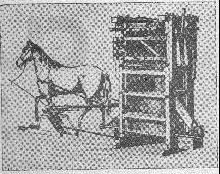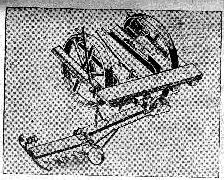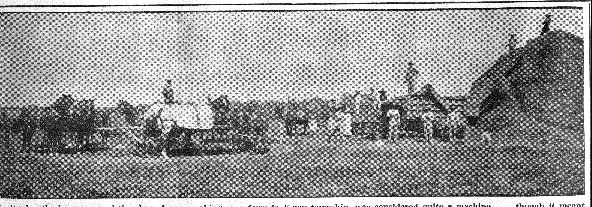More Farm Equipment
Source: Osceola Centennial Issue...1851 to 1951, Osceola Sentinel,
August 2, 1951, Section 1, p. 8.
Rilea Implement Co., the Allis-Chalmers dealer, also had a full-page ad in the Centennial
Issue showing some old farm machinery as well as "modern" machinery.
 Baling hay must have
been strenuous work in the 1850's when this rig was used. Hay was first
tramped in, then compressed into 250-pound bales. The press required two
men and a horse to operate, made five bales an hour. How the bales were
handled is not known by present machinery men.
Baling hay must have
been strenuous work in the 1850's when this rig was used. Hay was first
tramped in, then compressed into 250-pound bales. The press required two
men and a horse to operate, made five bales an hour. How the bales were
handled is not known by present machinery men.
In the decade between 1850 and 1860...the years
in which Osceola
was established as a town... two-wheel mowers like that above were capturing
the interest of farmers. The machine featured a hinged cutterbar, a turning
point in design of the day.
Osceola
was established as a town... two-wheel mowers like that above were capturing
the interest of farmers. The machine featured a hinged cutterbar, a turning
point in design of the day.
 Spring-tooth sulky
rakes like this were just coming into use as pioneers
moved onto the Clarke county prairies. It was dumped by hand, could be used
for windrowing or bunching, and was considered an improved rake of the day
in 1850.
Spring-tooth sulky
rakes like this were just coming into use as pioneers
moved onto the Clarke county prairies. It was dumped by hand, could be used
for windrowing or bunching, and was considered an improved rake of the day
in 1850.
 Wooden plow of the Colonial days, pictured here, could
not plow deep, sometimes wore out in a single seaon. It met its master when
moved west to the prairie sod. Blacksmiths first solved the problem by fastening
steel saw blades over the surfaces of wooden moldboards.
Wooden plow of the Colonial days, pictured here, could
not plow deep, sometimes wore out in a single seaon. It met its master when
moved west to the prairie sod. Blacksmiths first solved the problem by fastening
steel saw blades over the surfaces of wooden moldboards.

In its day the horse-powered thresher, shown working on
a farm in Knox township, was considered quite a machine...though it meant
spending a good share of the summer trading threshing work, and cooking
for dozens of hands. Threshing rig above was owned by Sherman and Hugh Wilson
and was being operated on the Frank Rayl farm which now (1951) belongs
to Chet Henderson.
Return to Farming
 Baling hay must have
been strenuous work in the 1850's when this rig was used. Hay was first
tramped in, then compressed into 250-pound bales. The press required two
men and a horse to operate, made five bales an hour. How the bales were
handled is not known by present machinery men.
Baling hay must have
been strenuous work in the 1850's when this rig was used. Hay was first
tramped in, then compressed into 250-pound bales. The press required two
men and a horse to operate, made five bales an hour. How the bales were
handled is not known by present machinery men. Osceola
was established as a town... two-wheel mowers like that above were capturing
the interest of farmers. The machine featured a hinged cutterbar, a turning
point in design of the day.
Osceola
was established as a town... two-wheel mowers like that above were capturing
the interest of farmers. The machine featured a hinged cutterbar, a turning
point in design of the day. Spring-tooth sulky
rakes like this were just coming into use as pioneers
moved onto the Clarke county prairies. It was dumped by hand, could be used
for windrowing or bunching, and was considered an improved rake of the day
in 1850.
Spring-tooth sulky
rakes like this were just coming into use as pioneers
moved onto the Clarke county prairies. It was dumped by hand, could be used
for windrowing or bunching, and was considered an improved rake of the day
in 1850. Wooden plow of the Colonial days, pictured here, could
not plow deep, sometimes wore out in a single seaon. It met its master when
moved west to the prairie sod. Blacksmiths first solved the problem by fastening
steel saw blades over the surfaces of wooden moldboards.
Wooden plow of the Colonial days, pictured here, could
not plow deep, sometimes wore out in a single seaon. It met its master when
moved west to the prairie sod. Blacksmiths first solved the problem by fastening
steel saw blades over the surfaces of wooden moldboards.